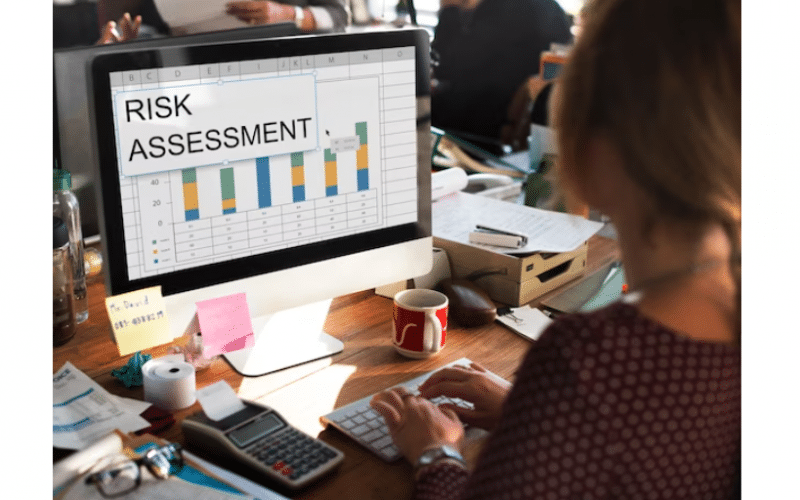Governance and risk management are crucial for businesses to identify risks and manage them to comply with industry guidelines and regulations. It helps businesses understand potential security concerns, legal obligations, internal policies, and external pressures. To stay ahead, businesses should implement automated compliance software, engage dedicated teams, perform audits, review policies, update training materials, and maintain records on regulatory compliance activities. Effective governance can reduce risks and ensure compliance with the rules.
In this article, we emphasize how effective governance reduces risks and ensures compliance.
What Is Governance And Risk Management?
Governance and risk management (GRC) is a new corporate management system that integrates three critical functions into every department’s processes. Additionally, governance and risk management address the “silo mentality,” where departments may resist sharing information or resources, reducing efficiency, and morale, and preventing positive company culture development.
How Does Governance And Risk Management Work?
Note that:
- The “silo mentality” that causes departments within a company to hoard information and resources is something that governance and risk management are designed to address.
- Every department has integrated governance and risk management systems for increased efficiency.
- Reduced risks, expenses, and duplication of effort are the main goals.
Overall, GRC aims to reduce risks, costs, and duplication of effort by requiring company-wide cooperation to achieve results meeting internal guidelines and processes for key functions.
What Is The Role Of Governance In Risk Management?
Businesses require a mechanism to efficiently identify and manage the organization’s essential activities as they become more complicated. Therefore, to improve the efficiency of people, business processes, technology, facilities, and other crucial business factors, it is also necessary to merge traditional discrete management functions into a unified discipline.
Governance accomplishes this by removing the conventional boundaries that exist between business units and requiring them to collaborate to realize the company’s strategic objectives.
What Are The Elements Of Governance And Risk Management?
We’ll define and go into detail about each of these three elements separately.
#1. Governance
Governance ensures the alignment of organizational activities, such as IT operations and training, with the organization’s goals and objectives. Key decision-makers, such as board members or high-level executives, enforce activities like board composition, corporate disclosure, and executive compensation.
Furthermore, effective governance involves using data, information, and hard evidence to develop strategies and decisions. Key sources include internal audits, assurance reports, compliance monitoring results, and risk assessments. Additionally, robust governance keeps the organization on track and aligned with defined objectives.
#2. Risk Management:
Risk management involves identifying, assessing, and controlling threats and risks to an organization, including financial pitfalls, legal consequences, cybersecurity threats, commercial liabilities, management errors, and natural disasters. It relies on internal audits and assessments to identify gaps and uncertainties.
Furthermore, organizations often assign various individuals to manage risk management, including IT security leaders, business analysts, finance officers, and the governance board. Note that a robust GRC framework aligns risk management activities with the organization’s goals and objectives.
#3. Compliance
Compliance involves aligning organizational activities with relevant laws and regulations, such as legal mandates or company policies. Additionally, compliance officers ensure systems comply with GDPR (General Data Protection Regulation), while environmental inspectors address violations at construction sites.
Furthermore, some frameworks promote centralized compliance monitoring, preventing financial, legal, and reputational consequences from breaking compliance. Failure to comply can lead to fines, court expenses, and a damaged reputation.
Does Risk Management Fall Under Governance?
Yes, risk management falls under governance, as they are two essential governance practices. However, few organizations can expect to succeed in the long run without implementing both disciplines. Even though each is necessary in its own right, they work best together.
What Does A Governance And Risk Analyst Do?
The Governance and Risk Analyst handles complex internal audit projects, including research, analysis, and reporting on policies, programs, governance, risk management, and internal controls. Additionally, their work may result in significant government policy, program, or financial changes.
Key Responsibilities Summary:
- Conduct investigation and data gathering based on the audit plan using interviews, document and system evaluations, observation, and literature and online searches for best practices.
- Consolidate information and build an understanding of departments, programs, funded agencies, policies, concerns, and priorities by using critical thinking, analytical abilities, and a whole-of-government approach.
- Analyze all available data, information, and research in light of predetermined criteria, provide findings and conclusions, and offer tactical insights.
- Create suggestions and/or innovative alternatives to existing solutions for complicated problems, such as alterations to governance, risk management, internal controls, and financial management procedures.
- Prepare thorough, convincing, and well-supported reports that clearly outline the audit’s methodology, results, conclusions, and suggestions for improvement.
- Participate in presentations with departments and operating reporting entities while clearly and succinctly conveying complex, and sensitive information.
What Are Examples Of Governance Risks?
Governance risks are challenges that can hinder an organization’s effective functioning and may have negative consequences. Examples include poor board oversight, conflict of interest, lack of transparency, inadequate risk management, weak internal controls, regulatory compliance failure, lack of diversity and inclusion, weak ethical culture, inefficient decision-making processes, and inadequate succession planning.
Furthermore, these risks can lead to mismanagement, improper decision-making, and potential corruption. Therefore, it is crucial to identify, assess, and manage these risks effectively to protect the organization’s interests and reputation. Note that the nature and context of an organization or institution can also impact specific governance risks.
What Are The 5 Governing Risks?
#1. Human capital
In mid-2021, there was an increase in employee turnover due to the normalization of working from home. There was a need for businesses to focus on talent and culture to stay competitive. The pandemic has led to intentionality around talent, recognizing burnout, and the need for a new approach to culture. Companies must design hybrid working models to positively impact talent acquisition and retention.
#2. Technology and cyber risk
A survey found that 30% of employees experienced a cyber breach in the past 16 months, with 70% linked to the work-from-home (WFH) environment. Note that the shift occurred during the COVID-19 pandemic, leaving insufficient time for cybersecurity measures. Organizations have struggled to address vulnerabilities, with board members and management teams facing challenges. Governance and risk management strategies can help build a stronger foundation with board members.
#3. Regulatory Change & Compliance
Businesses are unprepared to meet taxation, data privacy, ESG, and climate-related reporting obligations. Before these regulations were established, organizations had to reassess their technology and establish a solid foundation for streamlined compliance and reporting. Centralizing climate data is crucial for ‘collect once, reuse many times’.
However, increasing regulatory demands and investors’ differing demands complicate matters. Overloading high-value staff with data collection and calculation using spreadsheets is riskier and more error-prone than ever before.
#4. Supply Chain
Despite the pandemic, companies still struggle with supply chain resilience and market demand fluctuations. Enhancing supply chains involves seeking sustainable partners and mitigating third-party risks. Therefore, diversifying suppliers and rebuilding a robust infrastructure can help companies rebuild their resilience.
#5. Lack of Diversity
The Black Lives Matter movement in 2021 highlighted the need for equality and representation of minority groups in power positions, including corporate leadership. The absence of minority representation exposes companies to risks, such as mistakes harming performance and reputation. Therefore, businesses must prioritize progress toward commitments, focusing on transparency and diversity discussions.
Does Risk Management Fall Under Governance?
Yes, risk management falls under governance as they are two essential governance practices. However, few organizations can expect to succeed in the long run without implementing both disciplines. Even though each is necessary in its own right, they work best together.
What Is A Risk And Governance Manager?
A Risk and Governance Manager is responsible for risk management, control testing, and risk awareness, supporting non-financial risk management.
The roles of a risk and governance manager are:
Assisting in the establishment and testing of a control structure and assisting in the integration of the Bank’s risk management framework within Risk.
Creating and putting into place a comprehensive risk management procedure for the risk teams.
Advising, supervising and supporting the Risk teams to ensure that they proactively identify, manage, report, and monitor their main risk exposures.
Ensuring that measures are in place to evaluate the effectiveness of key procedures, offering direction and support to coworkers within Risk
Aiding in the testing of controls under the standards for control testing
Monitoring and enforcing audit points, risk and control self-assessment, and incident reporting
What Does A Governance And Risk Analyst Do?
The Governance and Risk Analyst handles complex internal audit projects, including research, analysis, and reporting on policies, programs, governance, risk management, and internal controls. Additionally, their work may result in significant government policy, program, or financial changes.
Key Responsibilities Summary:
- Conduct investigation and data gathering based on the audit plan using interviews, document and system evaluations, observation, literature, and online searches for best practices.
- Consolidate information and build an understanding of departments, programs, funded agencies, policies, concerns, and priorities by using critical thinking, analytical abilities, and a whole-of-government approach.
- Analyze all available data, information, and research in light of predetermined criteria, provide findings and conclusions, and offer tactical insights.
- Create suggestions and/or innovative alternatives to existing solutions for complicated problems, such as alterations to governance, risk management, internal controls, and financial management procedures.
- Prepare thorough, convincing, and well-supported reports that clearly outline the audit’s methodology, results, conclusions, and suggestions for improvement.
- Participate in presentations with departments and operating reporting entities while clearly and succinctly conveying complex and sensitive information.
What Are Examples Of Governance Risks?
Governance risks are challenges that can hinder an organization’s effective functioning and may have negative consequences. Examples include poor board oversight, conflicts of interest, lack of transparency, inadequate risk management, weak internal controls, regulatory compliance failure, a lack of diversity and inclusion, a weak ethical culture, inefficient decision-making processes, and inadequate succession planning.
Furthermore, these risks can lead to mismanagement, improper decision-making, and potential corruption. Therefore, it is crucial to identify, assess, and manage these risks effectively to protect the organization’s interests and reputation. Note that the nature and context of an organization or institution can also impact specific governance risks.
What Are The 5 Governing Risks?
#1. Human capital
In mid-2021, there was an increase in employee turnover due to the normalization of working from home. There was a need for businesses to focus on talent and culture to stay competitive. The pandemic has led to intentionality around talent, recognizing burnout, and the need for a new approach to culture. Companies must design hybrid working models to positively impact talent acquisition and retention.
#2. Technology and cyber risk
A survey found that 30% of employees experienced a cyber breach in the past 16 months, with 70% linked to the work-from-home (WFH) environment. Note that the shift occurred during the COVID-19 pandemic, leaving insufficient time for cybersecurity measures. Organizations have struggled to address vulnerabilities, with board members and management teams facing challenges. Governance and risk management strategies can help build a stronger foundation with board members.
#3. Regulatory Change and Compliance
Businesses are unprepared to meet taxation, data privacy, ESG, and climate-related reporting obligations. Before these regulations were established, organizations had to reassess their technology and establish a solid foundation for streamlined compliance and reporting. Centralizing climate data is crucial for ‘collect once, reuse many times’.
However, increasing regulatory demands and investors’ differing demands complicate matters. Overloading high-value staff with data collection and calculation using spreadsheets is riskier and more error-prone than ever before.
#4. Supply Chain
Despite the pandemic, companies still struggle with supply chain resilience and market demand fluctuations. Enhancing supply chains involves seeking sustainable partners and mitigating third-party risks. Therefore, diversifying suppliers and rebuilding a robust infrastructure can help companies rebuild their resilience.
#5. Lack of Diversity
The Black Lives Matter movement in 2021 highlighted the need for equality and representation of minority groups in power positions, including corporate leadership. The absence of minority representation exposes companies to risks, such as mistakes harming performance and reputation. Therefore, businesses must prioritize progress toward commitments, focusing on transparency and diversity discussions.
DANGERS OF AI: What Are the Risks of Artificial Intelligence (AI)?
WHAT IS RISK ANALYSIS: Definition, Techniques, and Benefits
WHAT IS THIRD PARTY RISK MANAGEMENT: A Comprehensive Guide






